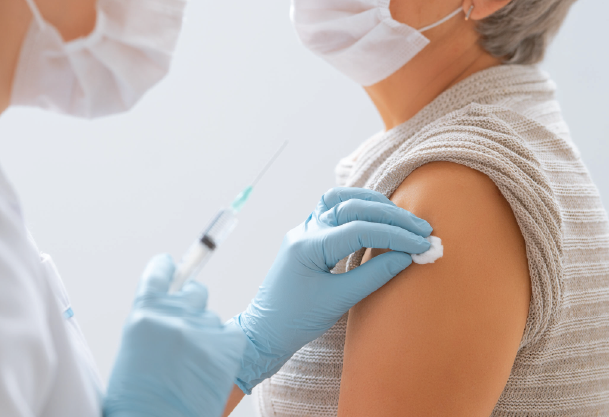News
Adjustment of Consultation Fee 2026
Please informed that new consultation fee will be adjusted as follows with effective 1 January 2026 :-ClinicNew consultation fee (HK$)CTL$550 (exclude any medication) MC5$420 (include 3 days’ basic medication)-Central clinic Tel : 2523 1808Address : 10/F, 33 Des Voeux Road Central, Central, Hong Kong(MTR Central Station Exit “B” or Hong Kong Station Exit “C”)-Kwun Tong clinic Tel : 2523 9383Address: Unit 2802, 28/F, BEA Tower, Millennium City 5, 418 Kwun Tong Road, Kowloon (MTR Kwun Tong Station Exit “A2”)
More
Special Service Arrangement for Christmas and New Year's Eve
Blue Care has special service arrangement-during Christmas and New Year's Eve as below.-Christmas Eve24 Dec 2025 (Wed)Christmas Day & The first weekday after Christmas Day25 & 26 Dec 2025 (Thur & Fri)Until 1300Closed New Year's Eve31 Dec 2025 (Wed)The first day of Jan1 Jan 2026 (Thur)Until 1600Closed -Wishing you a joyful Christmas filled with warmth, laughter, and love. May the New Year bring you new opportunities, good health, and continued success.
More
The Vaccination Subsidy Scheme 2025/26
The Vaccination Subsidy Scheme 2025/26 has been launched. Eligible persons can present relevant supporting document to receive influenza vaccination subsidy at Blue Care Medical Centre without extra charge._The eligible groups are Hong Kong residents who are:– Pregnancy women– Aged 50 years or above– Children between 6 months tounder 18 years or attending secondary schools in Hong Kong– Persons receiving disability allowance– Persons with Intellectual Disability– Persons who are recipients of standard rate of “100% disabled” or “requiring constant attendance” under Comprehensive Social Security Assistance– Persons aged 18 to 49 years with specified chronic medical conditions (New eligible group)-Please contact Blue Care Medical Centre for vaccination appointment.-Central clinic Tel : 2523 1808Address : 10/F, 33 Des Voeux Road Central, Central, Hong Kong(MTR Central Station Exit “B” or Hong Kong Station Exit “C”)-Kwun Tong clinic Tel : 2523 9383Address: Unit 2802, 28/F, BEA Tower, Millennium City 5, 418 Kwun Tong Road, Kowloon (MTR Kwun Tong Station Exit “A2”)-For more details, please click:FAQs on Flu Vaccine (Source: Hong Kong Department of Health)Possible Side Effects of Influenza Vaccine
More
Blue Care support 15 - Valent Pneumococcal Conjugate Vaccine
Blue Care Medical Centre provides the latest 15 - Valent Pneumococcal Conjugate (PCV15) vaccination service. Blue Care has joined Government Vaccination Schemes. The Enquiries and appointment is available now._According to the International Statistical Classification of Diseases and Related Health Problems (ICD), Pneumonia ranks as the second leading cause of death in Hong Kong. Its mainly caused by serotype 3. Streptococcus pneumoniae causes a wide range of diseases, more common ones include middle ear infection (acute otitis media) and chest infection (pneumonia)._Price:HK$1,650 per doseSupplier:MSDSuitable for:The age of 6 weeks or above_Notes:1. Prior doctor assessment before the first vaccination is included.2. Full payment of all doses must be made in the first vaccination. 3. Any fees paid will not be transferable and will not be refundable.4. Offer is valid while stock lasts.
More
Sniffles, Sneezes, and Allergies: Understanding and Managing Allergic Rhinitis
Allergic rhinitis is a widespread condition that affects individuals across all age groups. Characterized by symptoms such as sneezing, nasal congestion, and itchy eyes, this allergic reaction is triggered by exposure to environmental allergens.-Studies have shown that allergic rhinitis has become increasingly common in Hong Kong over the past two decades. Among school-aged children, the number of those experiencing symptoms rose from around 44% in the mid-1990s to over 56% by 2015 . Factors such as air pollution, high humidity, and year-round exposure to indoor allergens contribute to this upward trend.-What is Allergic Rhinitis?Allergic rhinitis is an inflammatory condition of the nasal passages that occurs when the immune system overreacts to certain airborne substances. These substances, known as allergens, are typically harmless to most people but can trigger a reaction in individuals with allergies.-There are two primary types of allergic rhinitis: seasonal and perennial. Seasonal allergic rhinitis tends to occur during specific times of the year, such as spring or autumn, when pollen counts are high. Perennial allergic rhinitis, on the other hand, is persistent throughout the year and usually caused by indoor allergens. Although not life-threatening, allergic rhinitis can significantly impact work performance, school attendance, sleep quality, and general well-being.-Common allergens include:●Dust mites●Pollen●Pet dander●Mold spores-Depending on the type of allergen and the timing of exposure, allergic rhinitis may be classified as:Seasonal allergic rhinitisPerennial allergic rhinitisOften triggered by outdoor allergens such as pollen from trees, grasses, or weeds.Caused by year-round exposure to indoor allergens such as dust mites and pet hair.-The immune system identifies these allergens as threats and releases histamines and other chemicals, leading to inflammation and symptoms in the nose, eyes, and throat.-Common Symptoms of Allergic RhinitisIndividuals with allergic rhinitis may experience a range of symptoms that vary in intensity. Common symptoms include:●Frequent sneezing●Runny or congested nose●Itchy nose, eyes, or throat●Watery eyes●Postnasal drip●Coughing●Fatigue due to poor sleep-These symptoms may be mistaken for the common cold, but unlike a cold, allergic rhinitis does not cause fever and may persist for weeks or longer. Individuals who experience symptoms regularly or during specific seasons should consider seeking medical advice for further evaluation.-Why Allergic Rhinitis is So Common in Hong KongSeveral environmental and lifestyle factors contribute to the high prevalence of allergic rhinitis in Hong Kong:● Air pollution: High levels of pollutants can aggravate the nasal passages and worsen allergic reactions.● Humidity: The humid climate supports the growth of mold and dust mites, which are common indoor allergens.●Urban living: Close quarters and limited ventilation in residential buildings can increase exposure to allergens.● Occupational exposure: Individuals working in environments with dust or chemicals may be at greater risk.-Additionally, increased awareness and improved diagnostic tools have led to higher rates of detection, particularly among children and the working population.-Diagnosis: How Is It Identified?Diagnosis of allergic rhinitis generally begins with a consultation that includes a detailed review of the patient’s medical history and a physical examination. Physicians will inquire about symptom frequency, duration, seasonal patterns, and any known or suspected triggers. This helps determine whether symptoms are consistent with allergic rhinitis or if other conditions, such as sinusitis or a common cold, may be involved.-If allergic rhinitis is suspected but the specific triggers are unclear, additional diagnostic tests may be recommended:Skin prick testA small drop of a suspected allergen is placed on the patient’s skin, usually on the forearm or back. The skin is then gently pricked so the allergen can enter the surface layer. If a red, raised bump appears within 15–20 minutes, it may indicate an allergic response. This test helps identify reactions to common allergens such as dust mites, pollen, mold, or pet dander.Blood tests (such as specific IgE testing)This involves drawing a blood sample to measure the presence of allergen-specific immunoglobulin E (IgE) antibodies. Blood tests are often used when skin testing is not advisable, such as in individuals with skin conditions, those taking certain medications, or young children.Nasal endoscopyIn cases where symptoms persist despite treatment or when physical blockages are suspected, a nasal endoscopy may be performed. This involves inserting a thin, flexible tube with a camera into the nasal passages to examine the nasal lining and structures. It can help rule out structural issues such as nasal polyps, deviated septum, or chronic sinus inflammation.-In some cases, a combination of tests may be used to ensure a comprehensive understanding of the condition. Accurate diagnosis not only confirms the presence of allergic rhinitis but also helps identify the specific allergens responsible, allowing for more targeted treatment and long-term symptom control.-Treatment and Management OptionsManaging allergic rhinitis involves a combination of medication, lifestyle adjustments, and in some cases, immunotherapy.Medication.--Several medications are available to help control symptoms:-AntihistaminesReduce sneezing, itching, and runny nose by blocking histamines.Nasal corticosteroidsHelp decrease inflammation in the nasal passages.DecongestantsProvide short-term relief of nasal congestion.Leukotriene receptor antagonistsUsed for patients with concurrent asthma or more severe allergies-These medications may be available over the counter or by prescription and should be used under the guidance of a healthcare professional.-Lifestyle and Environmental ControlMinimizing exposure to allergens is a key component of long-term management. Recommended steps include:●Using air purifiers with HEPA filters●Regularly washing bed linens and curtains●Vacuuming with a HEPA filter-equipped cleaner ●Avoiding carpets and upholstered furniture●Keeping windows closed during high pollen periods●Showering and changing clothes after spending time outdoors-These measures can help reduce the allergen load in living and working environments, especially for those with perennial symptoms.-ImmunotherapyFor individuals who do not respond well to standard treatments or prefer a long-term solution, immunotherapy may be an option. This involves gradually exposing the immune system to increasing amounts of the allergen to build tolerance.-Types of immunotherapy include:● Allergy shots (subcutaneous immunotherapy)●Sublingual immunotherapy (tablets or drops placed under the tongue)-Immunotherapy is typically administered over several years and is most effective when tailored to specific allergens identified during testing.-Taking Control of Allergic RhinitisAllergic rhinitis is a common and manageable condition that affects a significant portion of the population in Hong Kong. It can have a substantial impact on quality of life, but with timely diagnosis and appropriate treatment, most individuals can achieve effective symptom control.-Whether through medication, lifestyle changes, or immunotherapy, managing allergic rhinitis requires a comprehensive approach that addresses both the symptoms and their underlying triggers. Individuals experiencing persistent or severe symptoms are encouraged to seek medical advice to develop a personalized management plan.-Sources:Lee, S.-L., Lau, Y.-L., Wong, W. H.-S., & Tian, L.-W. (2022). Childhood wheeze, allergic rhinitis, and eczema in Hong Kong: ISAAC study from 1995 to 2015. International Journal of Environmental Research and Public Health, 19(24), 16503. https://doi.org/10.3390/ijerph192416503
More
Special Service Arrangements under Extreme Weather Conditions
Tropical Cyclone WarningIf Typhoon Signal No. 8 or above is issued, Blue Care Medical Centres will be closed-while the warning signal is in force.-Depending on the traffic and weather conditions, we will resume services gradually in 2 hours after the Typhoon Signal No. 8 or above is cancelled.-Black Rainstorm Warning SignalIf Black Rainstorm Warning Signal is issued before the clinic session, Blue Care Medical Centres will be closed-while the warning signal is in force. However, clinic remains openif the Black Rainstorm Signal is issued during the clinic session.-Depending on the traffic and weather conditions, we will resume normal services as soon as possible in 2 hours after the Black Rainstorm Warning Signal is cancelled.-Patients who have made their clinic appointments are advised to contact and confirm with the clinic before arrival, and clinic staff will contact the booked appointments for rearrangement.
More
The Masks of Depression: High-Functioning, Smiling, and Elder Depression
Depression rates in Hong Kong have recently reached high levels, with severe depression skyrocketing by over 30% compared to 2020 .Most concerning is that 44% of young respondents aged 18 to 24 now experience moderate to severe depressive symptoms . As Hong Kong society develops, uncertainty about future prospects becomes increasingly apparent among young people. Though it may seem obvious, depression affects all age groups, including older adults who face unique challenges. While depression receives extensive coverage, some lesser-talked-about forms of depression are worthy of discussion as well: depression in the elderly, high-functioning depression, and smiling depression.-What is Depression and How is it Related to You?Depression is a common, severe mental disorder that negatively affects how you feel, think, and act. Unlike temporary sadness, clinical depression persists and significantly impairs daily functioning. Key depression symptoms include persistent sadness, losing interest in activities you once enjoyed, significant appetite changes, sleep disturbances, fatigue, and feelings of worthlessness.-Depression stems from various factors, including family dynamics, workplace stress, academic pressure, and social relationships. Those who have experienced abuse, severe losses, or chronic stressful events face a higher risk. In Hong Kong's high-pressure environment, many working professionals encounter multiple triggers simultaneously.-Depression may already be affecting your life directly. Whether you're experiencing symptoms yourself, concerned about a family member, or noticing changes in a colleague. In Hong Kong's demanding work culture, approximately 1 in 4 adults have experienced anxiety or depressive symptoms , making it likely that you or someone close to you will encounter this condition.-Depression in Older Adults and the ElderlyMany older adults mistakenly believe depression is a natural part of aging, poor health, or dementia. This misconception prevents or delays proper treatment and worsens outcomes.-Elder depression often results from traumatic life events such as spousal death, loss of independence, or significant health diagnoses. Additional contributing factors include limited mobility, social isolation, facing mortality, and medication side effects. Signs of depression in the elderly differ from younger populations. Rather than expressing sadness directly, older adults may report persistent physical complaints, memory problems, or loss of appetite. Some elders refuse to discuss emotional struggles due to cultural stigma surrounding mental health, making detection more difficult.-What is the Geriatric Depression Scale (GDS)?The Geriatric Depression Scale is an extensively tested questionnaire specifically designed to identify possible depression in older adults. This validated screening tool addresses unique presentation patterns in elderly populations and avoids age-related physical symptoms that might confuse diagnosis.-The GDS comes in two versions: a comprehensive 30-question long form and a practical 15-question short form. Healthcare providers typically use the short form as the longer version proves time-consuming and difficult for some patients to complete. Within the 15-item version, 10 questions indicate depression when answered positively, while 5 indicate depression when answered negatively .-In Hong Kong, the GDS has been widely used to provide valuable insights into our community’s mental health landscape. A 2018 study by Baptist Oi Kwan Social Service found that 15% of Hong Kong participants scored 6 or above , indicating a borderline depressed state, highlighting the significant prevalence of elder depression in our community.-High-Functioning DepressionHigh-functioning depression represents a deceptive form where individuals maintain outward success while experiencing internal turmoil. These patients appear productive, meeting all daily and life responsibilities, and seem well-adjusted to colleagues and family members. Beneath the surface, they struggle with persistent depressive symptoms.-People with high-functioning depression experience similar symptoms to major depression, such as persistent sadness, hopelessness, fatigue, and diminished interest, but develop sophisticated masking strategies. They maintain work performance, fulfil social obligations, and project competence. This creates the illusion that everything is under their control and well-managed. -In Hong Kong's achievement-oriented culture, high-functioning depression is particularly common among professionals who fear career consequences of appearing vulnerable. Social media exacerbates this by showcasing curated happiness while concealing the authentic struggles that lie beneath. The constant pressure to maintain appearances prevents many from seeking necessary treatment.-Smiling DepressionWhile not officially listed in mental health diagnostic manuals, smiling depression describes individuals who appear happy externally while experiencing significant internal depression. Medical professionals increasingly recognize this presentation pattern, particularly in cultures with high mental health stigma.-Those with smiling depression maintain cheerful expressions while feeling profound sadness, hopelessness, or emptiness internally. They may often tell others that they feel fine and actively project happiness through social interactions, professional demeanor, and social media presence.-Cultural factors significantly influence smiling depression prevalence. In societies where mental illness carries heavy stigma, individuals may feel compelled to hide authentic emotions to maintain social standing. Perfectionists and those fearing perceived weakness are particularly susceptible. Though it might be hard to identify, there are signs one may see within someone who is experiencing smiling depression. A mismatch between expressed mood and behavior, excessive people-pleasing, reluctance to discuss personal struggles, and perfectionist tendencies are all signs that may signify someone is going through smiling depression.-Unveiling Depression's Many FacesDepression isn’t always what we expect. High-functioning individuals can continue to excel professionally while battling internal turmoil, whereas others maintain a constant cheerfulness to avoid stigma or appear strong. Meanwhile, older adults may suffer in silence, believing their symptoms are inevitable parts of aging rather than treatable conditions.-Understanding these forms of depression as friends or family members is crucial, as untreated depression worsens over time, affecting not just the individual but their families, workplaces, and communities. If you recognize these patterns in yourself or others, seeking professional help is a crucial step toward genuine healing and well-being.-Sources:1. Hong Kong depression rates reach new highs. (2024). The Standard. Available from: https://www.thestandard.com.hk/breaking-news/article/213040/Hong-Kong-depression-rates-reach-new-highs2. What is Depression?. (2024). American Psychiatric Association. Available from: https://www.psychiatry.org/patients-families/depression/what-is-depression3. Depressive disorder (depression). (2023). WHO. Available from: https://www.who.int/news-room/fact-sheets/detail/depression4. Depression in older people. (2023). Health Direct. Available from: https://www.healthdirect.gov.au/depression-in-older-people5. Your Guide to Understanding Depression in Elderly and Older Adults. (2025). Healthline. Available from: https://www.healthline.com/health/depression/elderly6. Geriatric Depression Scale (GDS). (2020). American Psychological Association. Available from: https://www.apa.org/pi/about/publications/caregivers/practice-settings/assessment/tools/geriatric-depression7. The Geriatric Depression Scale (GDS). (N.D). HIGN. Available from: https://hign.org/consultgeri/try-this-series/geriatric-depression-scale-gds8. 社區長者情緒健康調查-報告摘要. (2017). Baptist Oi Kwan Social Service. Available from:https://www.bokss.org.hk/content/press/46/201718%20%E7%A4%BE%E5%8D%80%E9%95%B7%E8%80%85%E6%83%85%E7%B7%92%E5%81%A5%E5%BA%B7%E8%AA%BF%E6%9F%A5%EF%BC%8D%E5%A0%B1%E5%91%8A%E6%91%98%E8%A6%81%20Final.pdf10. What Is High-Functioning Depression? Signs and Symptoms. (2024). Cleveland Clinic. Available from: https://health.clevelandclinic.org/high-functioning-depression11. 7 Signs You’re Dealing with High-Functioning Depression. (2024). Redoak Recovery. Available from: https://www.redoakrecovery.com/addiction-blog/7-signs-youre-dealing-with-high-functioning-depression/12. Smiling Depression: What You Need to Know. (2024). WebMD. Available from: https://www.webmd.com/depression/smiling-depression-overview
More
Understand Uterine Fibroids: Causes, Symptoms, and Treatments Available
Uterine fibroids are common, normally non-cancerous, tumors that develop in or around the uterus. Affecting an estimated 20-40% of women of reproductive age in Hong Kong , these growths can vary in size and may not always cause symptoms. However, for some women, fibroids can lead to significant health issues, including heavy bleeding, pain, and even fertility challenges.-The awareness of women’s health in Hong Kong is growing, and understanding the causes, symptoms, and treatment options for uterine fibroids has become an important aspect of maintaining overall reproductive health. For women in Hong Kong, where busy work schedules often overlap with family responsibilities, early awareness and timely treatment are crucial for preventing complications.-What are Uterine Fibroids?Uterine fibroids are benign growths that develop in the uterus, typically made of muscle and fibrous tissue. They can appear anywhere within the uterus, classified based on their location:Intramural fibroidsThese grow within the uterine wall and are the most common type.Submucosal fibroidsThese are located just beneath the inner lining of the uterus and can affect menstrual cycles significantly.Subserosal fibroidsThese grow on the outer surface of the uterus and can cause pain or pressure on nearby organs.Pedunculated fibroidsThese grow on a stalk-like structure, either inside or outside the uterus.-Though most fibroids do not lead to major health concerns, they can cause significant discomfort and complications in some women. It’s essential to be aware of the symptoms, especially if they significantly impact your daily life.-What are the Causes of Uterine Fibroids?The exact cause of uterine fibroids remains unclear , but several factors are believed to contribute to their development.-1. Hormonal Imbalance: The growth of fibroids is heavily influenced by the hormones estrogen and progesterone. These hormones stimulate the growth of the uterine lining during each menstrual cycle, and when fibroids are present, they respond similarly, growing in size. This explains why fibroids are more common in women of reproductive age.-2.Genetic Factors: Family history plays a significant role in the development of fibroids. If your mother or sister had fibroids, your risk of developing them increases. Certain genetic mutations have also been linked to fibroid growth.-3.Other Risk Factors: Several other factors can increase the likelihood of developing uterine fibroids, including:○Obesity: Higher body fat levels can contribute to higher estrogen levels, which may increase the likelihood of fibroid development.○High blood pressure: Women with hypertension may be at higher risk for fibroids.○Pregnancy: The hormonal changes that occur during pregnancy can sometimes encourage the growth of fibroids.-Understanding these risk factors can help you take preventative measures, such as maintaining a healthy weight and seeking early medical advice if you have a family history of fibroids.-Why do Uterine Fibroids Cause Bleeding?One of the most common symptoms of uterine fibroids is abnormal bleeding, which can range from heavy periods to prolonged bleeding. But why do fibroids cause such bleeding?-1. How Fibroids Affect Menstrual Cycles: Fibroids, particularly submucosal fibroids, can cause heavy menstrual bleeding because they interfere with the normal contraction of the uterine muscles during menstruation. This can lead to a buildup of the endometrial lining, causing prolonged and heavier periods.-2. Impact on the endometrial shedding: The presence of fibroids can also disrupt the normal shedding of the uterine lining. Fibroids may cause an irregular blood flow and prevent the proper shedding of the lining, which results in heavier and longer periods.-Women with fibroids often report not only heavier periods but also blood clots and prolonged bleeding that can last several days longer than normal. If these symptoms interfere with daily life, it's important to consult a doctor for an evaluation.-Common Symptoms of Uterine FibroidsUterine fibroids often don’t cause noticeable symptoms, but when they do, they can significantly impact a woman's quality of life. Some of the most common symptoms include:Heavy menstrual bleedingThis is one of the most common signs of fibroids, often leading to anemia due to excessive blood loss.Pelvic pain or pressureThis can be due to the size of the fibroid or its position within the uterus.Frequent urinationLarge fibroids can put pressure on the bladder, causing the need to urinate more often.Lower back painFibroids that press on the spine or nearby muscles can lead to chronic back pain.Pain during intercourseSome women may experience pain during sex, especially if the fibroid is located near the cervix.-If you experience any of these symptoms, it’s important to speak with your doctor. Though they may not always indicate fibroids, they could point to other health concerns that require medical attention.-How are Uterine Fibroids Diagnosed?Diagnosing uterine fibroids typically begins with a pelvic exam, during which your doctor may feel for any abnormal growths in the uterus. If fibroids are suspected, further diagnostic tests may be required, such as:-●Ultrasound:The most common method used to identify fibroids, ultrasound uses sound waves to create an image of the uterus and any growths inside it.●MRI: For more detailed images, an MRI may be used to assess the size, location, and number of fibroids.●Hysteroscopy: In some cases, a small camera is inserted through the cervix to directly observe the inside of the uterus.-Early diagnosis is crucial, as untreated fibroids can lead to complications, such as infertility or severe anemia from excessive bleeding.-Blue Care provide Female check-up plan. The checke-up offer up to 52% off. Click here-to check the plan details.-How to Remove Uterine FibroidsThere are several treatment options available to manage uterine fibroids, ranging from non-surgical methods to surgery, depending on the severity of the symptoms.-Non-surgical TreatmentsMedicationsHormonal treatments, such as birth control pills or GnRH agonists, can shrink fibroids by reducing estrogen levels. Over-the-counter pain relievers may help manage mild symptoms.MRI-guided focused ultrasoundA non-invasive treatment that uses high-frequency sound waves to destroy fibroid tissue without the need for surgery.Surgical TreatmentsMyomectomyThis procedure involves the removal of fibroids while preserving the uterus, making it an option for women who wish to retain fertility.Hysterectomy Insevere cases, a hysterectomy may be recommended. This is the removal of the uterus and is typically considered when fibroids are large, or other treatments have failedUterine artery embolization (UAE)This procedure involves blocking the blood vessels that supply the fibroids, causing them to shrink over time.-Empowering Your Uterine Fibroid ManagementUterine fibroids are common, but they can cause discomfort and affect daily life if left untreated. Understanding the causes, symptoms, and treatment options available can help you make informed decisions about your health.-If you suspect you may have fibroids or are experiencing symptoms, consult a healthcare provider for a thorough diagnosis and personalized treatment plan. With the right care, fibroids can be effectively managed.-Sources:1.The Hong Kong College of Obstetricians and Gynaecologists. (2009). Guidelines for the Management of Uterine Leiomyoma. Number 13. Published by The Hong Kong College of Obstetricians and Gynaecologists, a Foundation College of Hong Kong Academy of Medicine. Available at: https://www.hkcog.org.hk/hkcog/Download/Guidelines_for_the_Management_of_Uterine_Leiomyoma_2009.pdf2.Johns Hopkins Medicine. (n.d.). Uterine Fibroids. Available at: https://www.hopkinsmedicine.org/health/conditions-and-diseases/uterine-fibroids
More









![[Aug] Blog 3 - Featured Image_R0 (EN)](/Upload/news/43/thumbnail/3648d1fa9ff945228cae3522a301d912.jpg)
![[Aug] Blog 1 - Featured Image_R0 (EN)](/Upload/news/40/thumbnail/6f8cee6f9fd7429bb452e64cbafde5b7.jpg)